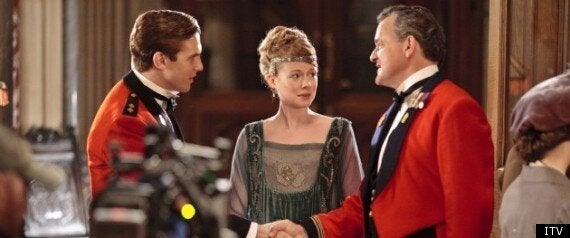We’re used to seeing chandeliers, butlers and idyllic settings in Downton Abbey. The furthest we moved away from luxury in the last series was when the scenes played out downstairs, in the kitchen.
So when Julian Fellowes wrote the new series, set during the First World War, the show’s producers knew they had a challenge on their hands.
The first scene in the first episode of the new series throws us straight into the trenches of The Somme, World War One. It’s no grand library or master bedroom.
Downton’s Executive Producer Gareth Neame and Series Producer Liz Trubridge had the task of not only making this a dramatic first scene to kick off the hotly-anticipated new series, but also a realistic representation of WW1.
Neame explained: “One thing we were conscious of, because of the success of the show last year, was that we had perhaps a larger audience on television that was going to learn about WW1 from Downton, than anything that has been on TV for years.
“There are endless documentaries about WW1 but we felt there was an entire generation that will be learning about it from this show. Because we’d achieved such a great production value here at Highclere Castle, we knew we had to get the same standard in the war scenes.
“We didn’t think it was acceptable to see Matthew Crawley going away and coming back on leave every so often.”

So how did the brains behind Downton manage to recreate The Somme in 2011?
Trubridge speaks proudly of their achievement: “We were very fortunate. We came across a wonderful man that owns his own set of trenches just outside Ipswich.
“When we saw the task and looked into what it was going to cost to recreate them by ourselves – it’s an engineering job of course – we thought we really don’t want to do this. Plus it would look just like a set which we couldn’t bear. We saw this man’s trenches and our designer said, ‘Give us two weeks and I can make this really good at a quarter of the price'.”
They also enlisted the help of Downton’s very own historical advisor, Alastair Bruce, who "was in the army and dug a few trenches in [his] time.”
Bruce added: “As historical advisor it was great fun to work with the actors and extras and talk about battle, danger and fear and how it affects people in that situation.
“I think that was part of the element that helped the overall sense of drama, for us, the people who were part of making it work, we were often quite overwhelmed after a take.”
The dark trench scenes make you think about the horrendous things the young men of WW1 went through, as do the hospital scenes featuring veteran amputees. It’s quite an achievement for an ITV drama, especially compared to the way war is often glamourised in films.
“Some of the extras we used in the war sequences were either ex-soldiers themselves or aficionados of the First World War, they cared about it and I think that makes a big difference,” Trubridge reasoned.
They certainly work well and in stark contrast with the Earl of Grantham’s luxurious home at Downton.
Although CGI was used to give the trenches “width”, the producers assured us hi-tech special effects were not enlisted.
Instead, camera men came up with a “wobbilator”. Trubridge explained: “Every time an explosion happened they’d press the start button and it would wobble – hi-tech.”
Neame agreed, basic tactics were employed: “If you have enough explosions and there are enough cameras moving around a lot then you tend to get some good stuff. Whereas, when you’re filming at Highclere, everything has to be precise and well orchestrated.”
Both promised that, although the series is still very much about Downton and the people that work there, they had to have a bit of a sense of where the men were going and what it was that impacted on them.
And impact it does. As Lady Sybil exclaims in the first episode of what’s set to be another cracker of a series, “Sometimes it feels like all the men I’ve ever danced with are dead.”
